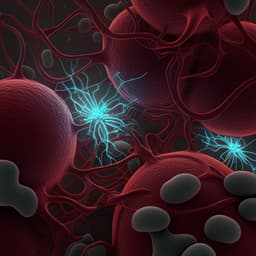
Medicine and Health
A critical role of brain network architecture in a continuum model of autism spectrum disorders spanning from healthy individuals with genetic liability to individuals with ASD
B. Khundrakpam, N. Bhutani, et al.
This study by Budhachandra Khundrakpam and colleagues explores the intricate relationship between brain network architecture and autism spectrum disorder (ASD). Utilizing data from ABIDE and PING, the researchers delve into cortical alterations associated with ASD and polygenic risk, revealing stronger implications in cortical hubs. The findings underscore the pivotal role of brain networks in understanding ASD.
~3 min • Beginner • English
Introduction
Neuroimaging studies consistently demonstrate cortical anatomical alterations in individuals with autism spectrum disorders (ASD). Large-scale work (e.g., ENIGMA) reports increased cortical thickness in frontal cortex and decreased thickness in temporal cortex in ASD. Importantly, ASD-related cortical alterations extend dimensionally into the general population, supporting a continuum model where autistic traits are normally distributed and clinical diagnosis represents the severe tail. Prior work shows cortical thickness in frontal/parietal regions relates to genetic risk for ASD in the general population and overlaps with alterations in clinical ASD. A key addition is examining underlying brain network architecture, particularly hubs (highly connected regions), which shape disorder-related morphological alterations in several psychiatric conditions. Hubs may be particularly vulnerable due to high metabolic demands and connectivity. Beyond hubs, disease epicenters—regions whose network embedding drives whole-brain patterns—have been identified across disorders. This study examines links between brain network architecture and (i) ASD-related cortical alterations (ASD vs CTL differences in cortical thickness) and (ii) cortical correlates of polygenic risk for ASD (PRS-ASD). Using normative structural brain networks from diffusion MRI, the authors test whether hub vulnerability parallels ASD-related alterations and PRS-related cortical correlates. They further test whether structural connectomes can predict PRS-ASD and whether top predictive regions correspond to ASD disease epicenters.
Literature Review
The introduction synthesizes evidence that: (1) ASD is associated with cortical thickness alterations across development, with increased frontal and decreased temporal thickness (ENIGMA and other studies). (2) Autistic traits and neural differences extend into the general population, consistent with a dimensional/continuum framework. (3) Network neuroscience demonstrates that brain hubs are disproportionately implicated in psychiatric disorders and that network architecture can shape spatial patterns of atrophy or cortical alterations. (4) Disease epicenters have been used to explain network-spread-like patterns in disorders such as Alzheimer’s, schizophrenia, and Parkinson’s disease. This background motivates assessing hub involvement and epicenters in ASD and relating network measures to cortical correlates of genetic liability (PRS-ASD).
Methodology
Datasets: Two cohorts were used. (i) Clinical cohort (ABIDE): MRI scans of males only after exclusions; final N=560 (ASD=266, CTL=294), ages ~17.2±6.4 (ASD) and 17.0±6.4 (CTL). (ii) General population (PING): initially 1493, filtered to European ancestry (GAF_Europe ≥0.95) and quality-controlled; final N=391 (207 males/184 females; age=12.1±4.7 years).
Genomics and PRS computation (PING): 550k SNPs genotyped (Illumina Human660W-Quad). Pipeline: imputePrepSanger (CBRAIN) for pre-imputation prep; imputation via Sanger Imputation Service with HRC reference; post-imputation QC with PLINK (unique SNP names, ACTG alleles, MAF>0.05; INFO R²>0.9 using PLINK 2.0). PRS was computed using PRSice 2.1.2, excluding ambiguous variants, yielding 4,696,385 variants for scoring. Individuals with European ancestry retained (N=526) and top 20 genetic PCs computed. GWAS training dataset: ASD GWAS (18,381 ASD cases, 27,969 controls). Clumping: distance 250 kb, threshold 0.1, p=0.001 cutoff. Final PRS based on 1,245 variants.
Structural MRI preprocessing (ABIDE and PING): CIVET pipeline used to compute cortical thickness at 81,924 vertices. Steps: non-uniformity correction; linear registration to MNI152 template; repeat non-uniformity correction with template mask; non-linear registration to MNI152; tissue segmentation (GM, WM, CSF); surface extraction with CLASP; cortical thickness computed as linked distance between inner/outer GM surfaces in native space; surface-based diffusion smoothing with 30 mm FWHM. Two independent reviewers performed QC; exclusions based on motion, SNR, vascular hyperintensities, surface issues.
Diffusion MRI preprocessing (PING): FSL v5.0.9 pipeline: eddy current, motion, susceptibility corrections; rigid alignment (flirt) of b0 to structural; non-linear registration (fnirt) to MNI152; forward/backward warp fields computed. Diffusion parameters estimated via MCMC sampling, modeling up to 2 fiber populations per voxel after 2000 iterations. QC included visual checks; exclusions for SNR<800 and frame-wise displacement >2 mm.
Sample characteristics: ABIDE final N=560 males (ASD=266, CTL=294); cortical thickness data normally distributed; variances similar (ASD var=0.0187 vs CTL var=0.0182; F=1.02, p=0.82). PING final N=391; PRS-ASD and cortical thickness normally distributed.
Structural connectivity: 62 cortical ROIs (subcortical regions removed). Structural connectivity matrices computed as mean streamline counts between ROI pairs (62x62). Ventricles used as exclusion mask. Zero connections not omitted; fiber counts not log-transformed.
Hub determination: Degree centrality computed from normative structural connectivity matrices to identify hubs (Brain Connectivity Toolbox). Degree centrality used to model nodal stress, consistent with prior literature.
Statistical analyses:
- ASD vs CTL cortical thickness (ABIDE): Vertex-wise GLM T_i = intercept + β1 Site + β2 Group + β3 Age + ε_i. Age mean-centered; site/scanner included as covariates. SurfStat used.
- PRS-ASD association with cortical thickness (PING): Vertex-wise GLM T_i = intercept + β1 Age + β2 PRS + β3 PC20 + β4 Scanner + β5 Sex + ε_i. PCs (20) included to control population stratification; scanner (device serial number) included.
- Age interactions: For ABIDE, T_i = intercept + β1 Site + β2 Group + β3 Age + β4 Age×Group + ε_i. For PING, T_i = intercept + β1 Age + β2 PRS + β3 PC20 + β4 Scanner + β5 Sex + β6 Age×PRS + ε_i.
- Harmonization sensitivity: ComBat applied to raw cortical thickness; GLMs repeated for comparison.
Spatial overlap (hub involvement): Spin permutation tests used to assess spatial correlation between degree centrality maps and (i) ASD-CTL cortical difference map (ABIDE), (ii) PRS-ASD cortical association map (PING), and between centrality and age-interaction maps. 1000 spherical surface rotations used to generate null distributions; significance assessed at p<0.05.
Connectome predictive modeling (CPM): Structural connectivity (62x62) used to predict PRS-ASD with cross-validation. Steps: feature selection, feature summarization, model building, and prediction significance testing. Model performance assessed by correlation between true and predicted PRS-ASD. Top predictive edges visualized with BrainNet Viewer.
Disease epicenter analysis: For each region, correlations between regional structural connectivity profile (seed-based connectivity) and ASD-related cortical alteration map were computed. Significance evaluated via spin permutation. Regions with significant associations designated as ASD epicenters. Overlap between epicenters and CPM top predictors assessed.
Power analysis: ABIDE—alpha 0.05 (two-tailed), required N(ASD)≈253 for power≥0.80 to detect ASD-CTL cortical thickness differences. PING—anticipated r=0.20 between PRS-ASD and cortical thickness yields power=0.97 for N=391. MATLAB sampsizepwr and binofit used.
ComBat comparison: Findings replicated with ComBat-harmonized cortical thickness (see Supplementary S4).
Key Findings
- Hub involvement in ASD-related alterations: Degree centrality map significantly correlated with ASD-CTL cortical thickness difference map: r_spin=0.31, p=0.015, indicating hubs are more implicated than non-hub regions.
- Hub involvement in PRS-related correlates: Degree centrality significantly correlated with cortical correlates of PRS-ASD: r_spin=0.37, p=0.003.
- Age interactions:
- ASD-CTL age interaction map vs degree centrality: r_spin=0.38, p=0.002.
- PRS-ASD age interaction map vs degree centrality: r_spin=0.43, p=0.0005.
- Predicting PRS-ASD from structural connectomes: CPM predicted PRS-ASD with r=0.30, p<0.0001 (~9% variance explained).
- Top predictive connections (Table 2 and Fig. 3B):
- Left Caudal Anterior Cingulate – Left Lingual
- Left Pars Orbitalis – Left Pars Triangularis
- Left Inferior Parietal – Left Postcentral
- Left Caudal Middle Frontal – Left Superior Frontal
- Left Rostral Middle Frontal – Left Superior Frontal
- Left Pars Triangularis – Left Supramarginal
- Left Postcentral – Right Postcentral
- Right Lateral Orbitofrontal – Right Posterior Cingulate
- Right Inferior Temporal – Right Superior Temporal
These correspond to tracts including superior longitudinal fasciculus, inferior longitudinal fasciculus, anterior commissure, U-fibers within frontal lobe, and callosal fibers.
- Disease epicenters: Two regions—the left inferior parietal lobule (IPL.L) and left supramarginal gyrus (SMG.L)—were identified as ASD disease epicenters via significant correlations between regional seed connectivity and ASD-related cortical alterations. For these, seed connectivity correlated with ASD alteration map (examples shown): r=0.30, p=0.01; r=0.32, p=0.012.
- Spatial distribution of hubs consistent with prior studies (medial prefrontal, superior parietal, superior temporal). ASD group showed greater cortical thickness in left parietal, lateral frontal, and bilateral temporal regions.
- Sensitivity: Analyses repeated with ComBat-harmonized data yielded similar results.
Discussion
Findings demonstrate that the healthy brain’s network architecture, particularly hub organization, is closely aligned with both ASD-related cortical alterations and cortical correlates of polygenic risk for ASD. Hubs exhibited greater ASD-associated differences and stronger age-related interaction effects, consistent with nodal stress models whereby highly connected, metabolically demanding regions are more susceptible to pathology. The identification of disease epicenters (left inferior parietal and left supramarginal gyri) that also emerged as top predictors in CPM links network topology with spatial patterns of cortical alterations in ASD. These epicenters lie within multimodal integration zones implicated in visuospatial processing, language-related pathways, and social perception, aligning with hallmark sensory, motor, and socio-communicative features of ASD. The ability of structural connectivity to predict PRS-ASD further supports a continuum model wherein genetic liability manifests along a dimensional axis that links to brain network properties in the general population and to cortical differences in clinical ASD. Potential neurobiological mechanisms underlying observed cortical and connectivity alterations include changes in neuronal and microglial populations, synaptic spine density and pruning, myelination, and inflammatory processes, which could collectively modulate both cortical thickness and white matter organization in hub-enriched networks.
Conclusion
This study shows that normative brain network architecture, especially cortical hubs, plays a critical role in shaping ASD-related cortical alterations and cortical correlates of genetic liability. Structural connectivity predicted polygenic risk for ASD, and regions with top predictive connections (left inferior parietal and left supramarginal gyri) were also identified as disease epicenters of ASD. Together, these results support a continuum model of ASD spanning from genetic risk in healthy individuals to clinical manifestation. The work underscores the value of integrating polygenic risk scores with multimodal neuroimaging to elucidate the interplay between genetic liability and brain network-driven cortical alterations. Future work should expand multi-site harmonized analyses and longitudinal designs to further delineate developmental trajectories linking PRS, network architecture, and cortical change.
Limitations
Related Publications
Explore these studies to deepen your understanding of the subject.







